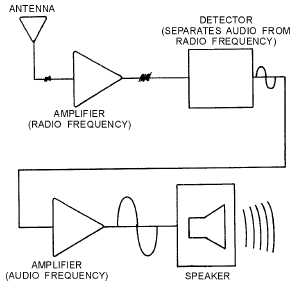1-3
Figure 1-2.—Amplifiers as used in radio receiver.
The audio signal from the detector will then be amplified to make it large enough to drive the
speaker of the radio.
Almost every electronic device contains at least one stage of amplification, so you will be seeing
amplifiers in many devices that you work on. Amplifiers will also be used in most of the NEETS modules
that follow this one.
Q-1. What is amplification?
Q-2. Does an amplifier actually change an input signal? Why or why not?
Q-3. Why do electronic devices use amplifiers?
CLASSIFICATION OF AMPLIFIERS
Most electronic devices use at least one amplifier, but there are many types of amplifiers. This
module will not try to describe all the different types of amplifiers. You will be shown the general
principles of amplifiers and some typical amplifier circuits.
Most amplifiers can be classified in two ways. The first classification is by their function. This
means they are basically voltage amplifiers or power amplifiers. The second classification is by their
frequency response. In other words what frequencies are they designed to amplify?
If you describe an amplifier by these two classifications (function and frequency response) you will
have a good working description of the amplifier. You may not know what the exact circuitry is, but you
will know what the amplifier does and the frequencies that it is designed to handle.
VOLTAGE AMPLIFIERS AND POWER AMPLIFIERS
All amplifiers are current-control devices. The input signal to an amplifier controls the current output
of the amplifier. The connections of the amplifying device (electron tube, transistor, magnetic amplifier,


